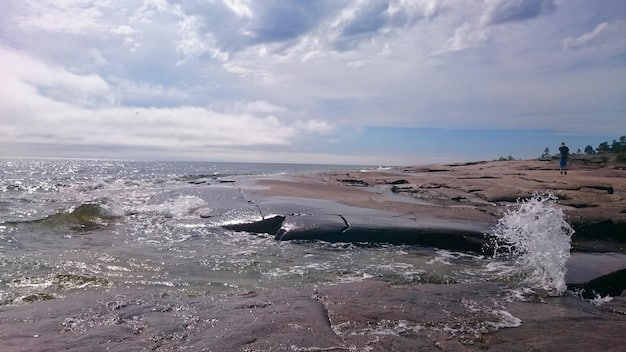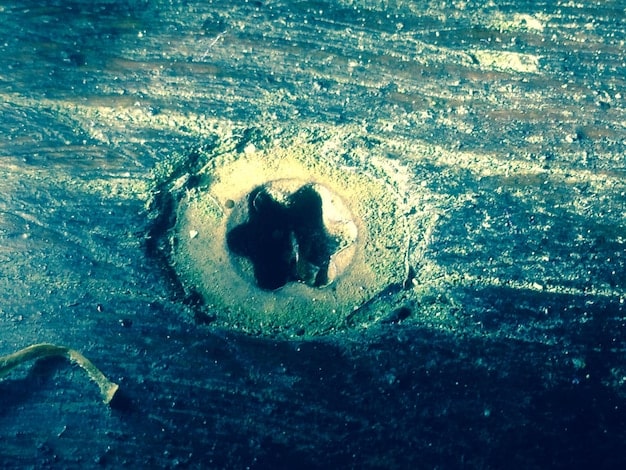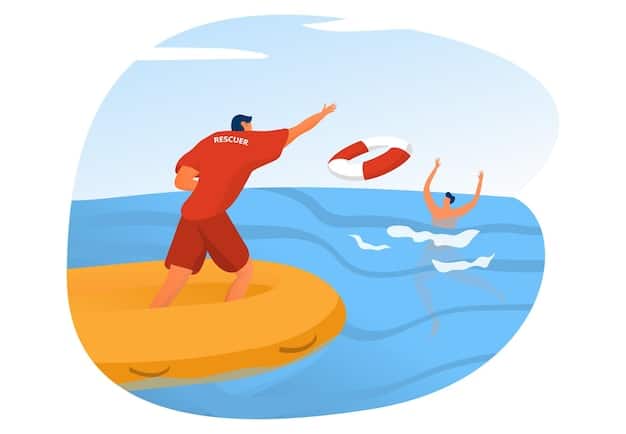Understanding Rip Currents: A Lifesaving Guide for Beachgoers

Understanding rip currents is crucial for beach safety; this guide provides beachgoers with essential knowledge on identifying, avoiding, and surviving these powerful ocean currents.
Heading to the beach should be a relaxing and fun experience, but it’s essential to be aware of potential dangers. Understanding rip currents: A lifesaving guide for beachgoers can ensure a safe and enjoyable time by equipping you with the knowledge to identify and avoid these hazardous currents.
What are Rip Currents?
Rip currents are powerful, narrow channels of water flowing away from the beach. They can occur at any beach with breaking waves and pose a significant risk to swimmers.
Understanding rip currents starts with recognizing their characteristics. They are not underwater currents that pull you under, but rather surface currents that transport you away from the shore.
Formation of Rip Currents
Rip currents typically form when waves break near the shoreline, piling up water between the breaking waves and the beach. This excess water needs to find a way back to the ocean, and it does so by forming a narrow, fast-moving current.
- Wave Action: Waves breaking unevenly can create areas of higher water accumulation.
- Channel Formation: Natural or man-made channels can concentrate the outflow of water.
- Obstructions: Jetties or sandbars can redirect water flow, leading to rip currents.
Recognizing Rip Currents
Identifying rip currents can be challenging, but there are several visual cues to look for. Being able to spot these signs is a key part of understanding rip currents and staying safe.
- Choppy, Discolored Water: A channel of choppy, discolored water moving away from the shore.
- Break in Wave Pattern: A break in the incoming wave pattern.
- Foam or Debris: A line of foam, seaweed, or debris moving seaward.
Recognizing these signs is the first step in avoiding danger. Always take a few minutes to observe the water conditions before entering the ocean.

By understanding how rip currents form and learning to identify them, you can significantly reduce your risk and enjoy a safer beach experience.
Why are Rip Currents Dangerous?
Rip currents are dangerous because they can quickly carry swimmers away from shore, causing panic and exhaustion. This can lead to drowning, especially for inexperienced or weak swimmers.
Understanding rip currents also involves recognizing the psychological and physical effects they can have on individuals caught in them.
Speed and Strength
Rip currents can reach speeds of up to 8 feet per second, which is faster than most people can swim. This speed combined with the current’s strength makes it difficult for even strong swimmers to overcome.
The force of the current can quickly tire out swimmers, increasing the risk of panic and drowning. It’s crucial to conserve energy if caught in a rip current.
Panic and Exhaustion
Being pulled away from shore can cause panic, leading swimmers to exhaust themselves trying to swim directly back to the beach against the current.
Understanding that rip currents don’t pull you under but rather away from shore is essential to avoid this panic-induced exhaustion.
Distance from Shore
Rip currents can extend hundreds of feet offshore, quickly carrying swimmers far from safety. This distance can make it difficult for rescuers to reach those in need.
- Rapid Displacement: The speed of the current can quickly increase the distance between the swimmer and the shore.
- Exposure to Elements: Being far from shore exposes swimmers to harsher environmental conditions.
- Delayed Rescue: The increased distance can delay rescue efforts.
Being aware of these dangers can help you make informed decisions about when and where to swim, as well as how to react if you find yourself caught in a rip current.
How to Survive a Rip Current
If you find yourself caught in a rip current, it’s crucial to stay calm and remember that you should not try to swim directly back to shore. Understanding rip currents means knowing how to respond effectively.
The primary strategy for surviving a rip current is to swim parallel to the shore until you are out of the current’s flow. Then, swim at an angle away from the rip current.
Stay Calm and Conserve Energy
Panic is your worst enemy in a rip current. Try to remain calm, float if possible, and conserve your energy. Yelling for help can alert others to your situation.
Conserving energy will allow you to think clearly and execute the necessary steps to escape the current. Focus on controlled breathing.
Swim Parallel to the Shore
Rip currents are typically narrow, so swimming parallel to the shore is the most effective way to escape. Swim sideways until you no longer feel the pull of the current.
- Identify the Current’s Width: Determine the extent of the rip current.
- Swim Perpendicular to the Flow: Move laterally to exit the current.
- Conserve Energy: Avoid fighting directly against the current.
Swim at an Angle Back to Shore
Once you are out of the rip current, swim at an angle away from the rip and back to the beach. This will prevent you from being pulled back into the current.
Evaluate your position and choose a safe path back to shore, considering the location of the rip current and any potential hazards.

By staying calm, swimming parallel to the shore, and then angling back to the beach, you can increase your chances of surviving a rip current and returning to safety.
Preventing Rip Current Incidents
Prevention is always better than cure. Taking steps to avoid rip currents can significantly reduce your risk of being caught in one. Understanding rip currents also involves knowing how to prevent incidents from occurring in the first place.
Choosing safe swimming locations and being aware of weather and water conditions are critical preventative measures.
Swim at Guarded Beaches
Beaches with lifeguards are the safest places to swim. Lifeguards are trained to identify rip currents and can provide assistance if needed.
Lifeguards monitor the water conditions and can warn swimmers of potential dangers. They also have the equipment and training to rescue those caught in rip currents.
Check Weather and Water Conditions
Before entering the water, check the local weather forecast and water conditions. Avoid swimming during periods of high surf or strong currents.
- Surf Reports: Surf reports provide information on wave height and current strength.
- Local Warnings: Heed any warnings or advisories issued by local authorities.
- Observation: Take time to observe the water conditions before entering the ocean.
Educate Yourself and Others
The more you know about rip currents, the better equipped you will be to avoid them. Share your knowledge with family and friends to help them stay safe as well.
Learning about rip currents and sharing that knowledge with others can create a safer environment for everyone at the beach.
By choosing guarded beaches, checking weather and water conditions, and educating yourself and others, you can help prevent rip current incidents and enjoy a safer beach experience.
Rip Current Safety Tips for Families
When visiting the beach with family, it’s essential to take extra precautions to ensure everyone’s safety. Understanding rip currents and implementing specific safety measures can help protect your loved ones.
Supervising children closely and teaching them about rip currents are vital steps to prevent accidents.
Supervise Children Closely
Always keep a close eye on children when they are in or near the water. Young children and inexperienced swimmers are particularly vulnerable to rip currents.
Designate a responsible adult to supervise children at all times. Avoid distractions such as phones or books.
Teach Children About Rip Currents
Educate children about the dangers of rip currents and how to identify them. Teach them what to do if they get caught in one.
- Visual Aids: Use diagrams or videos to explain rip currents.
- Practice Scenarios: Role-play how to respond if caught in a current.
- Reinforce Knowledge: Regularly review safety tips with children.
Establish a Meeting Point
Before heading to the beach, establish a meeting point in case someone gets lost or separated from the group. This can help prevent panic and ensure everyone can be accounted for.
Choose a landmark that is easily recognizable and accessible. Make sure everyone knows where the meeting point is and how to get there.
By supervising children closely, teaching them about rip currents, and establishing a meeting point, families can work together to create a safer beach experience for everyone.
| Key Point | Brief Description |
|---|---|
| ⚠️ Identify Rip Currents | Look for choppy water, breaks in wave patterns, and debris moving offshore. |
| 🏊 Swim Parallel | If caught, swim parallel to the shore until out of the current. |
| 🏖️ Swim at Guarded Beaches | Swim where lifeguards are present for quick assistance. |
| 🌊 Check Conditions | Always check weather and water conditions before swimming. |
Frequently Asked Questions (FAQs)
▼
A rip current is a narrow channel of water flowing offshore, caused by waves breaking near the beach pushing water towards the shore. This excess water finds an escape route, creating the current.
▼
Look for a break in the pattern of incoming waves, a channel of choppy, discolored water, or a line of foam/debris moving seaward. These are all signs of a potential rip current.
▼
Stay calm and don’t panic. Swim parallel to the shore until you are out of the current, then swim at an angle away from the rip and towards the beach. Float and call for help if needed.
▼
No, rip currents don’t pull you under. They carry you away from the shore on the surface. The danger comes from panic and exhaustion trying to swim against the current.
▼
Yes, beaches with sandbars, jetties, or piers are more prone to rip currents. These structures can disrupt the natural flow of water, creating channels where rip currents can form.
Conclusion
Understanding rip currents: A lifesaving guide for beachgoers equips you with the knowledge needed to stay safe at the beach. By being aware of the risks, knowing how to identify rip currents, and understanding how to respond if caught in one, you can enjoy your time at the beach with greater confidence and security. Remember to always swim at guarded beaches whenever possible and educate yourself and your family about rip current safety.





